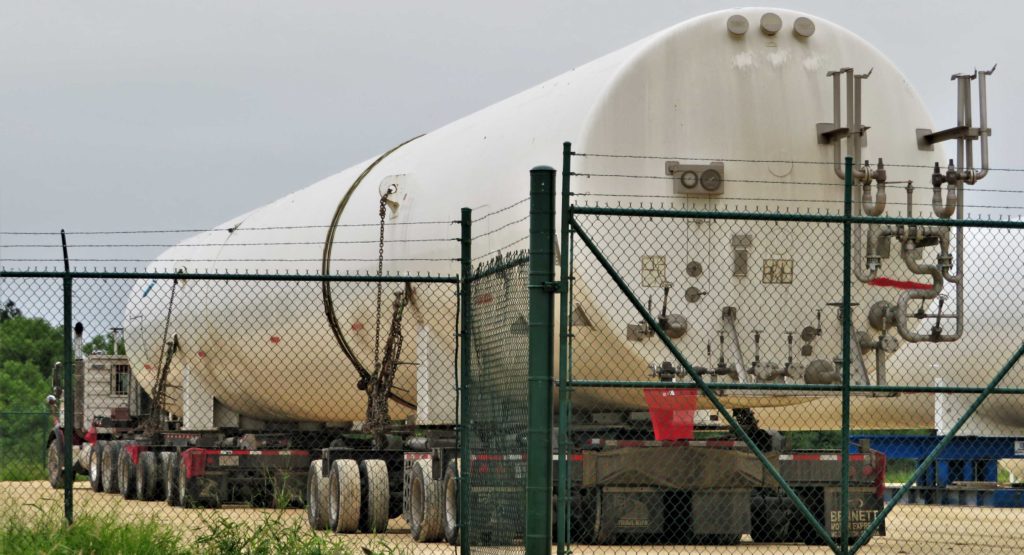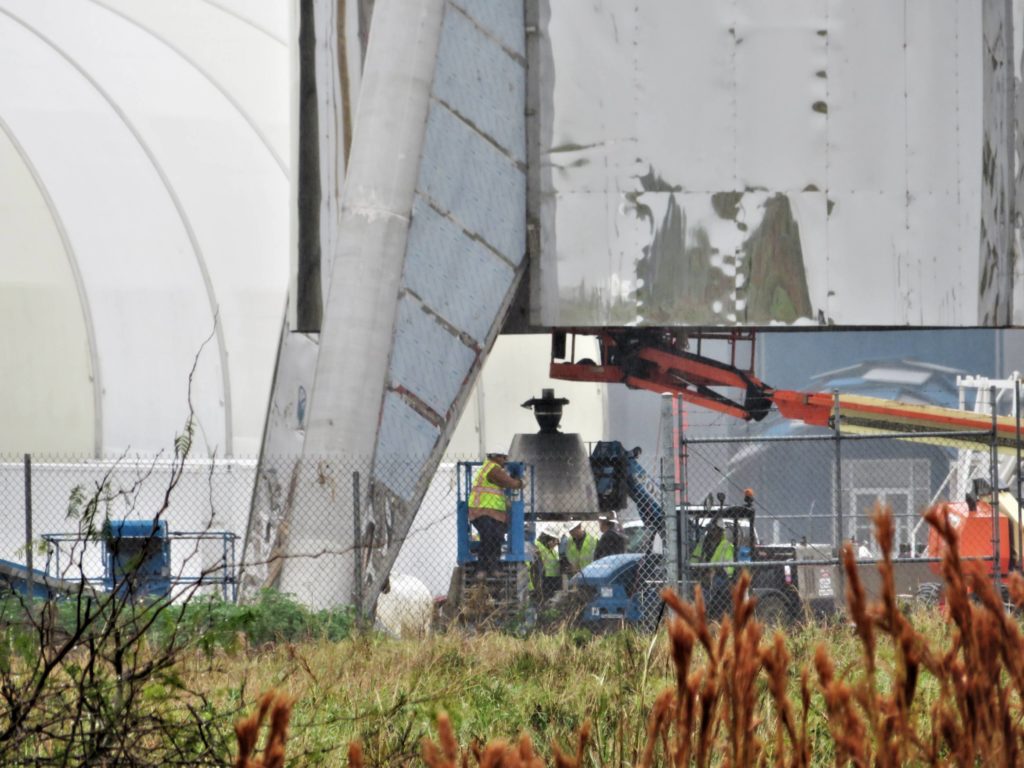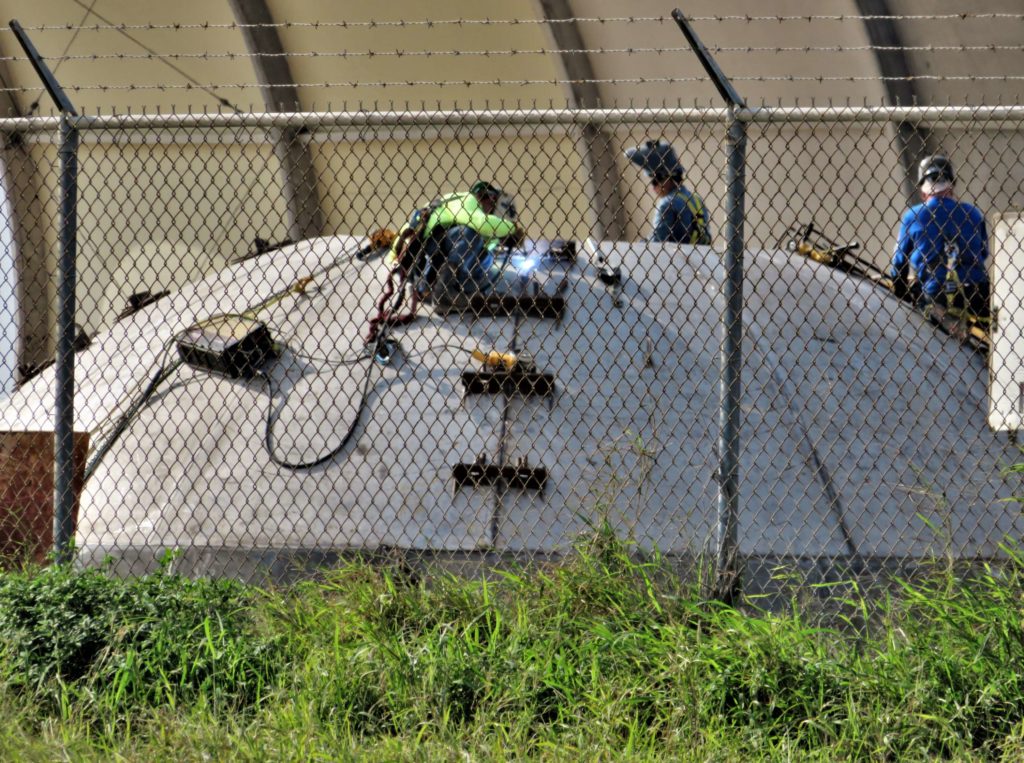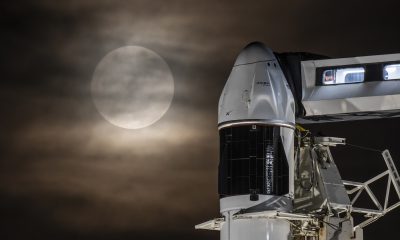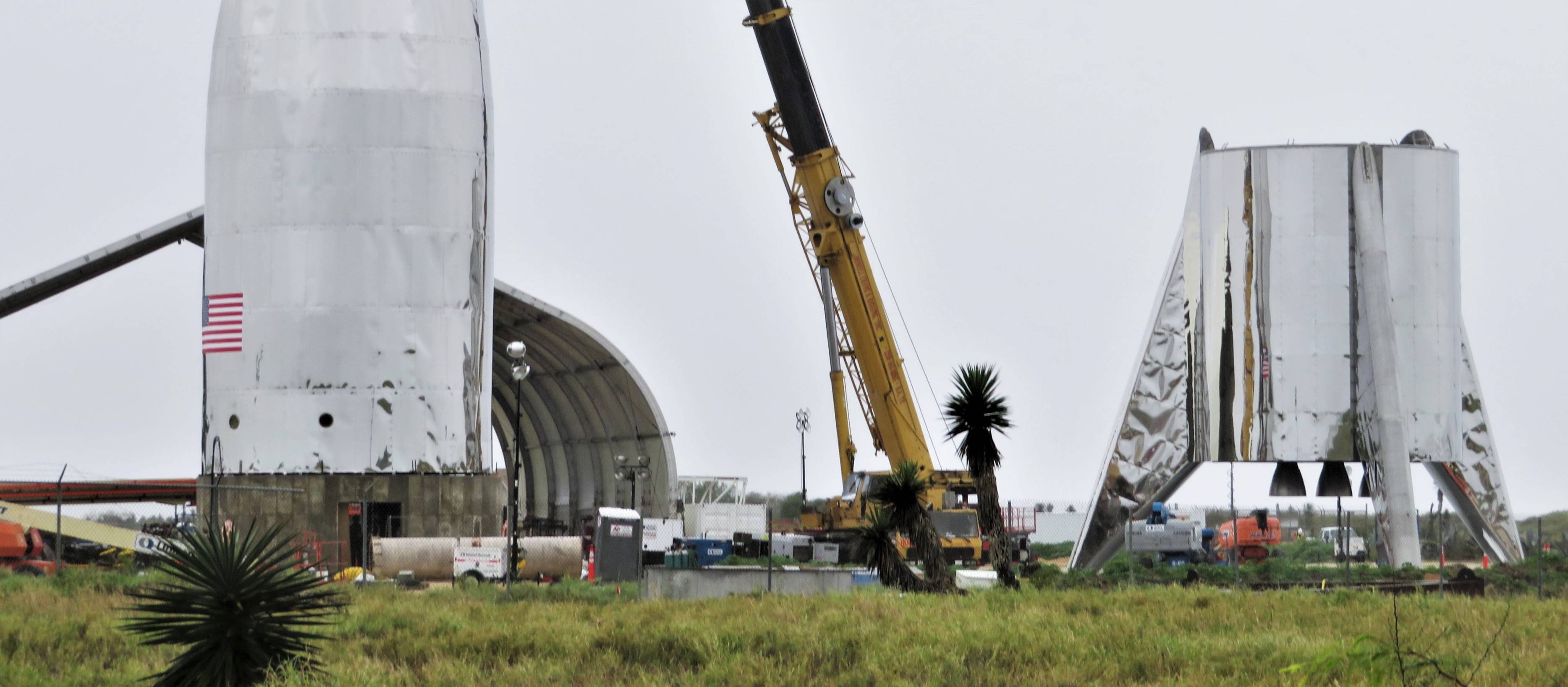

News
SpaceX separates Starship prototype’s nose and tail to install giant propellant tanks
After a handful of days as an impressive monolith stood along the coastal wetlands of Texas, SpaceX technicians have once again separated the nose and tail sections of the first Starship prototype to allow additional integration and assembly work to continue. The craft’s three Raptors were also removed and stored nearby, shown to be barebones facsimiles standing in for flightworthy hardware that could arrive in the next month or two.
Up next, three or four propellant tank domes – currently being assembled and welded together on-site – will likely be installed inside the steel hull of the giant Starship prototype’s aft barrel section. Known as bulkheads, the installation of those tank domes will bring SpaceX one step closer to performing hop tests of the simultaneously bizarre, confusing, and beautiful craft.
Starship Hopper has been taken apart again (for the installation of the bulkhead etc.)
📸NSF's BocaChicaGalhttps://t.co/DlTj9Qiijz
NSF Overview News Article by Thomas Burghardt @TGMetsFan98 for those catching up:https://t.co/rgliFAkBMC pic.twitter.com/DzSJzjSvoI
— NSF – NASASpaceflight.com (@NASASpaceflight) January 15, 2019
At this point in time, it appears that Starhopper is some odd combination of showmanship and actual hardware meant to test certain aspects of the first orbital Starship build, said to be complete as early as June 2019 by CEO Elon Musk. In the last week or so, SpaceX technicians attached and welded over Starhopper’s two sections – an aft barrel with legs and Raptors and a conical nose – and even did a sort of photoshoot, removing an on-site fence for a photo that Musk later shared while stating that the vehicle had “completed assembly”.
Starship test flight rocket just finished assembly at the @SpaceX Texas launch site. This is an actual picture, not a rendering. pic.twitter.com/k1HkueoXaz
— Elon Musk (@elonmusk) January 11, 2019
One could argue that assembly is not exactly complete if the given product has to be pulled in half to install significant new components. Regardless, the external skin, aft barrel section, and rough landing legs do appear to be more or less complete from a very basic structural perspective, although there is clearly much work still to be done if the vehicle’s tank bulkheads haven’t been installed. Aside from completing the liquid oxygen and methane tank structure, SpaceX engineers and technicians will additionally have to complete the vehicle’s aft section, a massive 9m/30ft-diameter thrust structure capable of supporting the thrust of three Raptor engines and the weight of the entire fueled rocket. After that, plumbing, avionics, sensors, attitude thrusters, and more will still need to be completed and integrated.
If Starhopper’s nose section is largely a nonfunctioning aerodynamic shroud and propellant tanks will be primarily located inside the aft section, the fuel and oxidizer capacities of the vehicle’s tanks can be roughly estimated. Assuming a 9m/30ft diameter, the aft barrel stands around 13m/43ft tall. Assuming that the upper tank dome will reach a meter or two above the steel cylinder and that the aft Raptor thrust structure is also roughly 1-2 meters deep, Starhopper would have a total tank volume around 830 m3 or almost 30,000 cubic feet (~225,000 gallons), potentially 1000 metric tons of fuel or more if fully loaded.
SpaceX ships another huge propellant tank to South Texas BFR test sitehttps://t.co/4L7f74gwg3 pic.twitter.com/KnHXOTCfAR
— TESLARATI (@Teslarati) October 24, 2018
- SpaceX has two of these tanks and two others that are smaller but still massive. (NASASpaceflight – bocachicagal, 10/23/18)
- Starhopper’s Raptor facsimiles were removed on January 15th. (NASASpaceflight – bocachicagal)
- Meanwhile, giant 9m-diameter tank domes are being assembled and welded together a few hundred feet away from Starhopper. (NSF – bocachicagal)
Perhaps less than coincidentally, SpaceX already has liquid methane and oxygen tanks on-site (one is pictured above) with more than enough capacity to meet Starhopper’s potential propellant needs. However, it’s worth noting that current plans (and permissions) only show Starhopper traveling as high as 5km on flights that will last no more than 6 minutes, and CEO Elon Musk has indicated in no uncertain terms that the prototype will remain distinctly suborbital and is primarily focused on fleshing out Starship’s vertical take-off or landing (VTOL) capabilities before SpaceX proceeds to much more aggressive tests.
While it would be safe to take his schedule with many dozens of grains of salt, Musk noted last week that the first orbit-ready Starship could be finished as early as June 2019, while he expects Starhopper tests to begin as early as February or March. Where exactly that orbital Starship and its Super Heavy booster partner will be built is now much less clear after SpaceX has reportedly canceled a berth lease and thus its plans to build a BFR factory in the Port of Los Angeles. Will SpaceX build a BFR factory in Texas or will it build the orbital Starship en plein air like its Starhopper predecessor? And Super Heavy? Where will all three conduct static fires, hops, or launches from?
Stay tuned as more details and photos continue to bubble up from beneath the surface.
News
Tesla UK sales see 14% year-over-year rebound in June: SMMT data
The SMMT stated that Tesla sales grew 14% year-over-year to 7,719 units in June 2025.

Tesla’s sales in the United Kingdom rose in June, climbing 14% year-over-year to 7,719 units, as per data from the Society of Motor Manufacturers and Traders (SMMT). The spike in the company’s sales coincided with the first deliveries of the updated Model Y last month.
Model Y deliveries support Tesla’s UK recovery
Tesla’s June performance marked one of its strongest months in the UK so far this year, with new Model Y deliveries contributing significantly to the company’s momentum.
While the SMMT listed Tesla with 7,719 deliveries in June, independent data from New AutoMotive suggested that the electric vehicle maker registered 7,891 units during the month instead. However, year-to-date figures for Tesla remain 2% down compared to 2024, as per a report from Reuters.
While Tesla made a strong showing in June, rivals are also growing. Chinese automaker BYD saw UK sales rise nearly fourfold to 2,498 units, while Ford posted the highest EV growth among major automakers, with a more than fourfold increase in the first half of 2025.
Overall, the UK’s battery electric vehicle (BEV) demand surged 39% to to 47,354 units last month, helping push total new car sales in the UK to 191,316 units, up 6.7% from the same period in 2024.
EV adoption accelerates, but concerns linger
June marked the best month for UK car sales since 2019, though the SMMT cautioned that growth in the electric vehicle sector remains heavily dependent on discounting and support programs. Still, one in four new vehicle buyers in June chose a battery electric vehicle.
SMMT Chief Executive Mike Hawes noted that despite strong BEV demand, sales levels are still below regulatory targets. “Further growth in sales, and the sector will rely on increased and improved charging facilities to boost mainstream electric vehicle adoption,” Hawes stated.
Also taking effect this week was a new US-UK trade deal, which lowers tariffs on UK car exports to the United States from 27.5% to 10%. The agreement could benefit UK-based EV producers aiming to expand across the country.
News
Tesla Model 3 ranks as the safest new car in Europe for 2025, per Euro NCAP tests
Despite being on the market longer than many of its rivals, the Tesla Model 3 continues to set the bar for vehicle safety.

The Tesla Model 3 has been named the safest new car on sale in 2025, according to the latest results from the Euro NCAP. Among 20 newly tested vehicles, the Model 3 emerged at the top of the list, scoring an impressive 359 out of 400 possible points across all major safety categories.
Tesla Model 3’s safety systems
Despite being on the market longer than many of its rivals, the Tesla Model 3 continues to set the bar for vehicle safety. Under Euro NCAP’s stricter 2025 testing protocols, the electric sedan earned 90% for adult occupant protection, 93% for child occupant protection, 89% for pedestrian protection, and 87% for its Safety Assist systems.
The updated Model 3 received particular praise for its advanced driver assistance features, including Tesla’s autonomous emergency braking (AEB) system, which performed well across various test scenarios. Its Intelligent Speed Assistance and child presence detection system were cited as noteworthy features as well, as per a WhatCar report.
Other notable safety features include the Model 3’s pedestrian-friendly pop-up hood and robust crash protection for both front and side collisions. Euro NCAP also highlighted the Model 3’s ability to detect vulnerable road users during complex maneuvers, such as turning across oncoming traffic.
Euro NCAP’s Autopilot caution
While the Model 3’s safety scores were impressive across the board, Euro NCAP did raise concerns about driver expectations of Tesla’s Autopilot system. The organization warned that some owners may overestimate the system’s capabilities, potentially leading to misuse or inattention behind the wheel. Even so, the Model 3 remained the highest-scoring vehicle tested under Euro NCAP’s updated criteria this year.
The Euro NCAP’s concerns are also quite interesting because Tesla’s Full Self-Driving (FSD) Supervised, which is arguably the company’s most robust safety suite, is not allowed for public rollout in Europe yet. FSD Supervised would allow the Model 3 to navigate inner city streets with only minimal human supervision.
Other top scorers included the Volkswagen ID.7, Polestar 3, and Geely EX5, but none matched the Model 3’s total score or consistency across categories. A total of 14 out of 20 newly tested cars earned five stars, while several models, including the Kia EV3, MG ZS, and Renault 5, fell short of the top rating.
Elon Musk
Why Tesla’s Q3 could be one of its biggest quarters in history
Tesla could stand to benefit from the removal of the $7,500 EV tax credit at the end of Q3.

Tesla has gotten off to a slow start in 2025, as the first half of the year has not been one to remember from a delivery perspective.
However, Q3 could end up being one of the best the company has had in history, with the United States potentially being a major contributor to what might reverse a slow start to the year.
Earlier today, the United States’ House of Representatives officially passed President Trump’s “Big Beautiful Bill,” after it made its way through the Senate earlier this week. The bill will head to President Trump, as he looks to sign it before his July 4 deadline.
The Bill will effectively bring closure to the $7,500 EV tax credit, which will end on September 30, 2025. This means, over the next three months in the United States, those who are looking to buy an EV will have their last chance to take advantage of the credit. EVs will then be, for most people, $7,500 more expensive, in essence.
The tax credit is available to any single filer who makes under $150,000 per year, $225,000 a year to a head of household, and $300,000 to couples filing jointly.
Ending the tax credit was expected with the Trump administration, as his policies have leaned significantly toward reliance on fossil fuels, ending what he calls an “EV mandate.” He has used this phrase several times in disagreements with Tesla CEO Elon Musk.
Nevertheless, those who have been on the fence about buying a Tesla, or any EV, for that matter, will have some decisions to make in the next three months. While all companies will stand to benefit from this time crunch, Tesla could be the true winner because of its sheer volume.
If things are done correctly, meaning if Tesla can also offer incentives like 0% APR, special pricing on leasing or financing, or other advantages (like free Red, White, and Blue for a short period of time in celebration of Independence Day), it could see some real volume in sales this quarter.
You can now buy a Tesla in Red, White, and Blue for free until July 14 https://t.co/iAwhaRFOH0
— TESLARATI (@Teslarati) July 3, 2025
Tesla is just a shade under 721,000 deliveries for the year, so it’s on pace for roughly 1.4 million for 2025. This would be a decrease from the 1.8 million cars it delivered in each of the last two years. Traditionally, the second half of the year has produced Tesla’s strongest quarters. Its top three quarters in terms of deliveries are Q4 2024 with 495,570 vehicles, Q4 2023 with 484,507 vehicles, and Q3 2024 with 462,890 vehicles.
-

 Elon Musk5 days ago
Elon Musk5 days agoTesla investors will be shocked by Jim Cramer’s latest assessment
-

 News1 week ago
News1 week agoTesla Robotaxi’s biggest challenge seems to be this one thing
-

 Elon Musk2 weeks ago
Elon Musk2 weeks agoFirst Look at Tesla’s Robotaxi App: features, design, and more
-

 News2 weeks ago
News2 weeks agoSpaceX and Elon Musk share insights on Starship Ship 36’s RUD
-

 News2 weeks ago
News2 weeks agoWatch Tesla’s first driverless public Robotaxi rides in Texas
-

 News1 week ago
News1 week agoWatch the first true Tesla Robotaxi intervention by safety monitor
-

 News2 weeks ago
News2 weeks agoTesla has started rolling out initial round of Robotaxi invites
-

 Elon Musk2 weeks ago
Elon Musk2 weeks agoTesla to launch in India in July with vehicles already arriving: report

